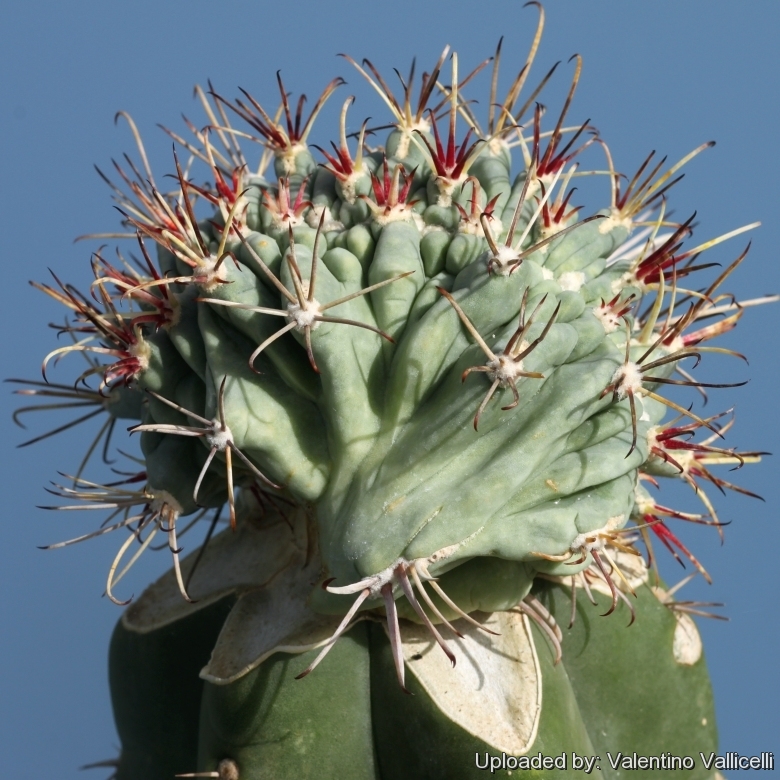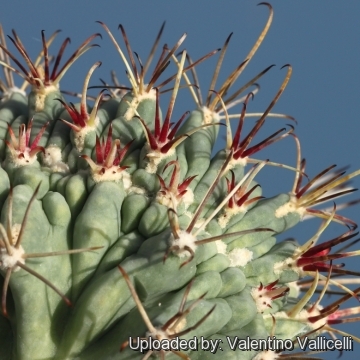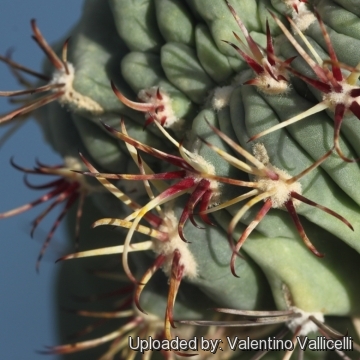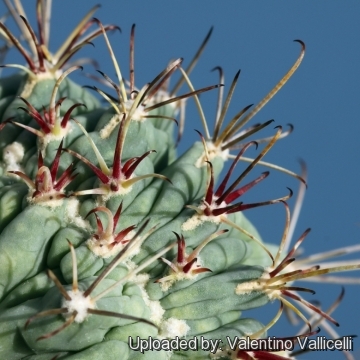Donate now to support the LLIFLE projects.
Your support is critical to our success.
Your support is critical to our success.
= Sclerocactus uncinatus subs. wrightii f. cristatus hort.
Accepted Scientific Name: Sclerocactus uncinatus subs. wrightii (Engelm.) N.P.Taylor
Cactaceae Consensus Init. 5: 13. 1998

Hamatocactus wrightii f. cristatus (Sclerocactus uncinatus subs. wrightii f. cristatus) Photo by: Valentino Vallicelli
Synonyms:
- Sclerocactus uncinatus subs. wrightii f. cristatus hort.
- Ancistrocactus uncinatus subs. wrightii f. cristatus hort.
- Echinocactus uncinatus var. wrightii f. cristatus hort.
- Echinomastus uncinatus var. wrightii f. cristatus hort.
- Ferocactus uncinatus var. wrightii f. cristatus hort.
- Glandulicactus uncinatus subs. wrightii f. cristatus hort.
- Glandulicactus wrightii f. cristatus hort.
- Hamatocactus wrightii f. cristatus hort.
- Pediocactus uncinatus var. wrightii f. cristatus hort.
- Thelocactus uncinatus var. wrightii f. cristatus hort.
See all synonyms of Sclerocactus uncinatus
back
Accepted name in llifle Database:Sclerocactus uncinatus (Galeotti) N.P.Taylor
Bradleya 5: 94. 1987
Synonymy: 8
- Sclerocactus uncinatus (Galeotti) N.P.Taylor
- Ancistrocactus uncinatus (Galeotti) L.D.Benson
- Echinocactus uncinatus Galeotti
- Echinomastus uncinatus (Galeotti) F.M.Knuth in Backeb. & F.M.Knuth
- Ferocactus uncinatus (Galeotti) Britton & Rose
- Glandulicactus uncinatus (Galeotti) Backeb.
- Hamatocactus uncinatus (Galeotti) Galeotti ex Borg
- Thelocactus uncinatus (Galeotti) Buxb.
Sclerocactus uncinatus subs. crassihamatus (F.A.C.Weber) N.P.Taylor
Cactaceae Consensus Init. 5: 13. 1998
Synonymy: 11
- Sclerocactus uncinatus subs. crassihamatus (F.A.C.Weber) N.P.Taylor
- Ancistrocactus crassihamatus (F.A.C.Weber) L.D.Benson
- Ancistrocactus uncinatus subs. crassihamatus (F.A.C.Weber) Doweld
- Echinocactus crassihamatus F.A.C.Weber in Bois
- Ferocactus crassihamatus F.A.C.Weber in Bois
- Glandulicactus crassihamatus (F.A.C.Weber) Backeb.
- Hamatocactus crassihamatus (F.A.C.Weber) Buxb.
- Hamatocactus uncinatus subs. crassihamatus (F.A.C.Weber) Glass
- Pediocactus uncinatus var. crassihamatus (F.A.C.Weber) Halda
- Sclerocactus uncinatus var. crassihamatus (F.A.C.Weber) N.P.Taylor
- Thelocactus crassihamatus (F.A.C.Weber) W.T.Marshall
Sclerocactus uncinatus subs. crassihamatus var. mathssonii (Berge ex K.Schum.) nov. comb. ined.
[Basionym: Echinocactus mathssonii Berge in K.Schum. 1898]
Synonymy: 5
- Sclerocactus uncinatus subs. crassihamatus var. mathssonii (Berge ex K.Schum.) nov. comb. ined.
- Ancistrocactus mathssonii (Berge ex K.Schum.) Doweld
- Echinocactus mathssonii Berge in K.Schum.
- Ferocactus mathssonii (Berge ex K.Schum.) N.P.Taylor
- Glandulicactus mathssonii (Berge ex K.Schum.) D.J.Ferguson
Sclerocactus uncinatus subs. wrightii (Engelm.) N.P.Taylor
Cactaceae Consensus Init. 5: 13. 1998
Synonymy: 27
- Sclerocactus uncinatus subs. wrightii (Engelm.) N.P.Taylor
- Ancistrocactus uncinatus subs. wrightii (Engelm.) Doweld
- Ancistrocactus uncinatus var. wrightii (Engelm.) L.D.Benson
- Echinocactus uncinatus var. wrightii Engelm.
- Echinocactus uncinatus f. wrightii (Engelm.) Schelle
- Echinocactus wrightii (Engelm.) J.M.Coult.
- Echinomastus uncinatus var. wrightii (Engelm.) F.M.Knuth
- Echinomastus uncinatus f. wrightii (Engelm.) Scheele
- Ferocactus uncinatus var. wrightii (Engelm.) N.P.Taylor
- Glandulicactus uncinatus subs. wrightii (Engelm.) U.Guzmán
- Glandulicactus uncinatus var. wrightii (Engelm.) Backeb.
- Glandulicactus wrightii (Engelm.) D.J.Ferguson
- Hamatocactus uncinatus var. wrightii (Engelm.) Bravo
- Hamatocactus wrightii (Engelm.) Orcutt
- Pediocactus uncinatus var. wrightii (Engelm.) Halda
- Sclerocactus uncinatus var. wrightii (Engelm.) N.P.Taylor
- Thelocactus uncinatus var. wrightii (Engelm.) H.P.Kelsey & Dayton
- Sclerocactus uncinatus subs. wrightii f. cristatus hort.
- Ancistrocactus uncinatus subs. wrightii f. cristatus hort.
- Echinocactus uncinatus var. wrightii f. cristatus hort.
- Echinomastus uncinatus var. wrightii f. cristatus hort.
- Ferocactus uncinatus var. wrightii f. cristatus hort.
- Glandulicactus uncinatus subs. wrightii f. cristatus hort.
- Glandulicactus wrightii f. cristatus hort.
- Hamatocactus wrightii f. cristatus hort.
- Pediocactus uncinatus var. wrightii f. cristatus hort.
- Thelocactus uncinatus var. wrightii f. cristatus hort.
back

Hamatocactus wrightii f. cristatus (Sclerocactus uncinatus subs. wrightii f. cristatus) Photo by: Valentino Vallicelli

Hamatocactus wrightii f. cristatus (Sclerocactus uncinatus subs. wrightii f. cristatus) Photo by: Valentino Vallicelli

Hamatocactus wrightii f. cristatus (Sclerocactus uncinatus subs. wrightii f. cristatus) Photo by: Valentino Vallicelli
Send a photo of this plant.
The gallery now contains thousands of pictures, however it is possible to do even more. We are, of course, seeking photos of species not yet shown in the gallery but not only that, we are also looking for better pictures than those already present. Read More...
The gallery now contains thousands of pictures, however it is possible to do even more. We are, of course, seeking photos of species not yet shown in the gallery but not only that, we are also looking for better pictures than those already present. Read More...
| Your Actions | |
|---|---|
| Back to Hamatocactus index | |
| Back to Cactaceae index | |
 |
Back to Cacti Encyclopedia index |








